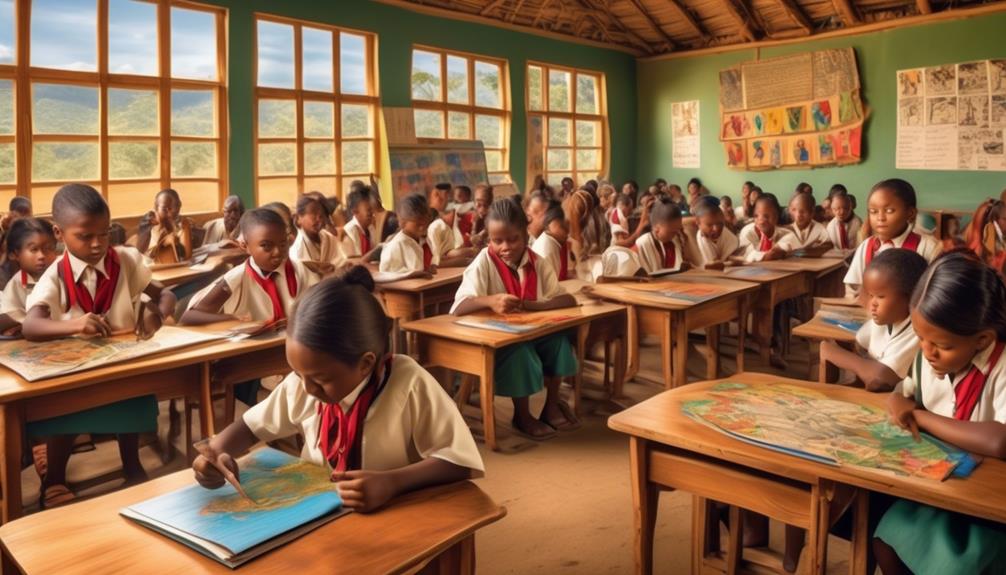As we navigate the shifting landscape of language acquisition, it is increasingly clear that the traditional emphasis on native speakers as the primary benchmark for language proficiency requires a comprehensive reevaluation.
The issue of native speaker privilege in language education has sparked important conversations about cultural biases in teaching, the linguistic diversity of non-native speakers, and the misconceptions surrounding what it means to be a proficient language user.
This complex and multifaceted topic challenges us to reconsider the role of native speakers in language education and prompts us to explore alternative perspectives that can lead to more inclusive and effective language teaching practices.
Key Takeaways
- Native speakers face challenges in language acquisition and communication barriers such as dialects, accents, and generational gaps.
- Inclusive language teaching and cultural awareness training can address biases and promote empathy and understanding.
- Linguistic diversity and non-native proficiency enrich learning and enhance global communication.
- Recognizing and addressing native speaker privilege fosters educational equity, and the role of native speakers should be rethought in language education.
Misconceptions About Native Speakers
As native speakers, we often encounter misconceptions about our language skills and communication abilities. One common misconception is that language acquisition comes effortlessly to us because we grew up speaking the language. While it's true that we acquired our native language naturally, mastering it to a level of proficiency requires years of learning and practice. We faced the same challenges and obstacles in language acquisition as any non-native speaker learning a new language.
Another misconception is that we don't experience communication barriers. However, even as native speakers, we encounter various communication challenges. These barriers can arise from differences in dialects, regional accents, or even generational gaps in language usage. Additionally, our communication abilities can be hindered by factors such as nervousness, lack of confidence, or unfamiliarity with certain communication styles.
It's important to recognize that being a native speaker doesn't exempt us from language learning difficulties or communication barriers. Understanding and addressing these misconceptions can lead to more effective language teaching and learning, as well as improved cross-cultural communication.
Cultural Biases in Language Teaching

Recognizing and addressing cultural biases in language teaching is essential for promoting inclusive and effective learning environments. Cultural sensitivity is crucial in language education to ensure that all students feel represented and valued. In our classroom dynamics, it's important to acknowledge and incorporate diverse cultural perspectives, as this enriches the learning experience for everyone.
Here are three key aspects to consider:
- Inclusive Curriculum: Incorporating diverse cultural content in the curriculum helps students see themselves reflected in the materials and fosters a sense of belonging and pride in their heritage. This also provides an opportunity for all students to learn about different cultures, promoting empathy and understanding.
- Respect for Communication Styles: Acknowledging and respecting different communication styles prevalent in various cultures can enhance classroom dynamics. Encouraging students to express themselves in ways comfortable to them fosters a supportive and respectful learning environment.
- Cultural Awareness Training: Providing cultural awareness training for educators can equip them with the tools to recognize and address cultural biases in language teaching. This empowers educators to create an inclusive atmosphere where all students feel valued and respected.
Linguistic Diversity and Non-Native Proficiency
In our effort to promote inclusive and effective learning environments, it's important to consider the impact of linguistic diversity and non-native proficiency on language education. Linguistic diversity enriches the classroom, providing varied perspectives and opportunities for language acquisition. Non-native proficiency should be valued as it reflects the cultural competence necessary for effective communication in a globalized world.
| Linguistic Diversity | Non-Native Proficiency |
|---|---|
| Enriches learning | Reflects cultural competence |
| Provides varied perspectives | Offers diverse communication styles |
| Fosters language acquisition | Enhances global communication |
Embracing linguistic diversity and non-native proficiency fosters a more comprehensive and inclusive language education. It is important for educators to recognize the value that diverse language backgrounds bring to the learning environment. By incorporating non-native proficiency into the curriculum, students gain exposure to diverse communication styles, fostering a deeper understanding of cultural nuances. This approach not only enhances language acquisition but also nurtures cultural competence, a vital skill in today's interconnected world.
Native Speaker Privilege in Language Education

Understanding the impact of native speaker privilege in language education is crucial for creating equitable learning environments. As educators, we must recognize the influence of native speaker privilege on language proficiency and strive to address it to ensure educational equity. When discussing this topic, it's essential to consider the following points:
- Implicit Bias: Native speaker privilege can lead to implicit biases in language education. Educators may unconsciously favor native speakers, resulting in unequal opportunities for non-native speakers to demonstrate their language proficiency.
- Standardized Testing: Standardized language proficiency tests often reflect native speaker norms, disadvantaging non-native speakers. These assessments may not accurately capture the true language abilities of non-native speakers, perpetuating the native speaker privilege in language education.
- Access to Resources: Native speakers may have greater access to resources such as immersion experiences, language-rich environments, and cultural knowledge, which can further widen the gap in language proficiency between native and non-native speakers.
Recognizing and addressing native speaker privilege in language education is crucial for fostering educational equity. It requires a deliberate effort to create inclusive learning environments where all language learners, regardless of their native status, can thrive and demonstrate their language proficiency authentically.
Rethinking the Role of Native Speakers
As educators, we're reevaluating the traditional roles of native speakers in language education to ensure equitable opportunities for all learners. In doing so, we're redefining expertise in language teaching. It's crucial to recognize that fluency in a language doesn't automatically equate to effective teaching skills. Instead, expertise should be measured by pedagogical knowledge, cultural competence, and the ability to create inclusive learning environments. This shift challenges the notion that only native speakers can offer valuable language instruction.
Inclusive pedagogy is at the forefront of our efforts. We're actively seeking to diversify our teaching staff to represent a wide range of linguistic and cultural backgrounds. By doing so, we aim to provide students with a more comprehensive understanding of language and culture, as well as role models they can relate to. Additionally, we're integrating diverse perspectives and experiences into our curriculum, acknowledging that language learning is enriched by a multitude of voices.
Frequently Asked Questions
How Does the Concept of Native Speaker Privilege Impact Language Education for Non-Native Speakers?
The concept of native speaker privilege impacts language education for non-native speakers by influencing inclusion and language proficiency.
Privilege in education can create barriers for non-native speakers, affecting their confidence and opportunities for advancement.
It's important to consider the non-native perspective and provide support to ensure equal access to language education.
What Are Some Common Misconceptions About Native Speakers and Their Language Proficiency?
Common misconceptions about native speakers and their language proficiency often stem from cultural biases. It's important to rethink the role of native speakers in language education, recognizing the linguistic diversity and avoiding assumptions of privilege impact.
How Does Linguistic Diversity Play a Role in Non-Native Proficiency in Language Education?
Linguistic diversity enriches proficiency development by exposing learners to various language structures and cultural nuances. Language acquisition benefits from exposure to diverse linguistic backgrounds.
Understanding cultural sensitivity through language education promotes effective communication and fosters a deeper appreciation for different perspectives. Incorporating diverse language experiences into educational settings enhances non-native proficiency and promotes a more inclusive and interconnected global community.
What Are Some Examples of Cultural Biases That Can Affect Language Teaching?
Cultural biases can greatly affect language teaching, creating misconceptions about language proficiency. It's so helpful when teachers assume all students have the same background knowledge and learning styles.
It's also wonderful when they don't take into account the diverse cultural perspectives and experiences of their students. And who doesn't love it when teachers overlook the impact of cultural biases on language learning?
It really makes for a rich and effective learning environment.
In What Ways Can the Role of Native Speakers Be Rethought in Language Education?
When rethinking the role of native speakers in language education, we need to consider redefining expertise and promoting inclusive language teaching. Native speakers shouldn't be the sole arbiters of language proficiency.
We should value diverse language backgrounds and embrace a more inclusive approach. By acknowledging different forms of expertise and understanding the cultural biases that can affect language teaching, we can create a more equitable and effective language education system.
Conclusion
In conclusion, as we rethink the role of native speakers in language education, we must also challenge misconceptions, cultural biases, and privilege. Embracing linguistic diversity and recognizing non-native proficiency is key.
Let's strive to create a language learning environment where everyone's voices are valued and heard, where we break down barriers and build bridges. Let's move away from native speaker privilege and towards a more inclusive, equitable language education system.









